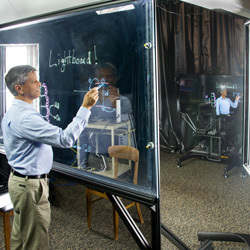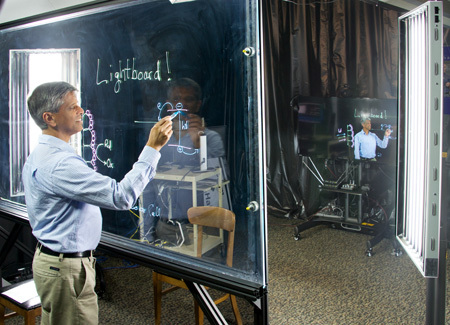

The Lightboard studio is located in 208 Jordan Hall of Science.
The University of Notre Dame is dedicated to providing an unsurpassed education to its students. Integral to that mission is bringing new and innovative teaching methods to the classroom.
Over the summer the Academic Technologies Group in the Office of Information Technologies (OIT) and the College of Science installed a new teaching tool called the Lightboard, which is used to create short videos intended to complement teaching efforts. The Lightboard consists of a glass board for writing notes and a camera to film the professor. It can also incorporate PowerPoint or Keynote slides onto the board that can be annotated by the professor during filming.
The Lightboard was developed by Michael Peshkin, a mechanical engineering professor at Northwestern University. Peshkin uses the Lightboard regularly and has even posted a step-by-step online tutorial for other institutions to install their own Lightboard.
Jim Parise, teaching professor of chemistry and biochemistry, first learned about the Lightboard during a meeting about new classroom technologies and lecture capture with Chaz Barbour in OIT. Immediately recognizing the potential for this technology, a group from Notre Dame met with Peshkin at Northwestern last spring to see the Lightboard in person. The group quickly secured funding for the project and a room for the studio, and construction was completed in a matter of months.
“This is a novel way to present material because it allows the instructors to face the viewer and draw diagrams, equations, or formulas the same way they would write on a chalkboard or whiteboard in class,” Parise explained. “What really attracted me to the Lightboard is that it is really easy to use and the final video is very high quality. This is much better than filming a lecture by traditional means in a classroom.”
Faculty can produce videos to “flip” their classroom. In a flipped classroom, students watch a video lecture before class, and professors use class time to focus on problem solving and applications of the lecture material. The Lightboard can also be used to film tutorials for solving difficult problems or explanations of more complex topics that would otherwise take up a significant amount of class time. Videos can be shared with students several ways -- Sakai, Box, YouTube or a professor’s own website.
“Several faculty have told me they are looking forward to using it,” said Malgorzata Dobrowolska-Furdyna, associate dean for undergraduate studies in the College of Science. “Many already have a vision for how they want to use the Lightboard. When the college starts using the Lightboard regularly, I know we will see our faculty create surprising, innovative ways to use it.”
The Lightboard studio is located in 208 Jordan Hall of Science. The final technical details are being completed and it will be ready for use in a few weeks. A calendar will be available to reserve times to use the Lightboard, and the college will send announcement to all science faculty when the Lightboard is ready for use.
“My advice for all science faculty is to just try the Lightboard,” said Dobrowolska-Furdyna. “We have many resources available to help with the Lightboard. Practice filming a few short videos, and post them when you are ready.” Parise has already created two tutorial videos for the Lightboard and an instructional manual will be posted in the studio.
The group that collaborated on the Lightboard project included Chaz Barbour and Brian Burchett of OIT; John Slaughter of Engineering & Science Computing; and Greg Crawford, Malgorzata Dobrowolska-Furdyna, Bill O’Hayer, Jim Parise, and Allen Utterback, of the College of Science.
Any questions about the Lightboard initiative can be directed to either Jim Parise or Malgorzata Dobrowolska-Furdyna.
Sample Lightboard Videos
Introduction to the Lightboard
Lightboard: Best Practices
Organic Chemistry Video: Complex Splitting